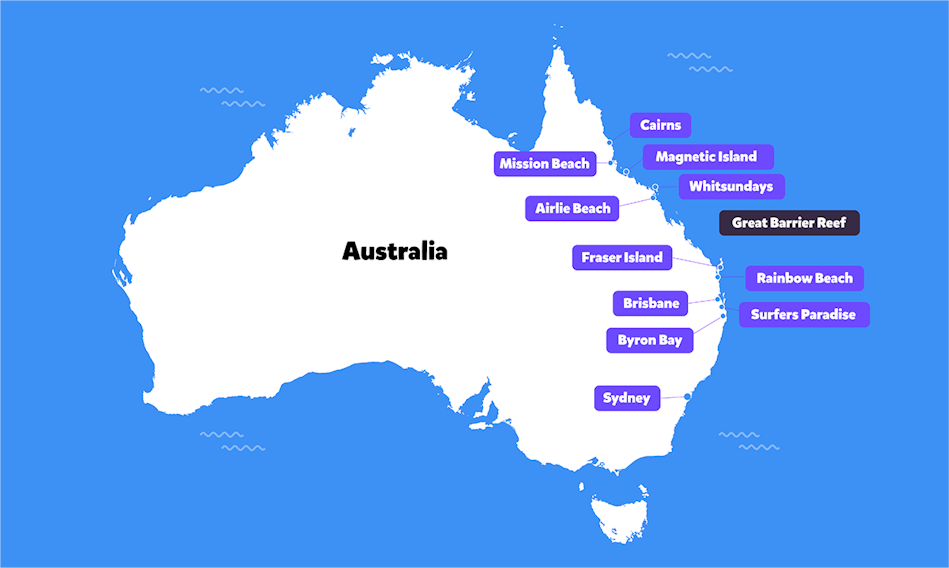Australia’s East Coast stretches over 2,500 kilometres, so the weather can vary a lot depending on where you are. From tropical rainforests in the north to temperate beaches in the south, each region has its own rhythm. This guide breaks it down zone by zone, so you know what to expect and when to go, whether you're chasing sunshine, surf, or the best time to explore. You can check out our Australia tours here.

Tropical North (Cairns, Whitsundays, Magnetic Island)
Welcome to the tropics! Up here in northern Queensland, the climate is warm year-round, but the wet and dry seasons define your experience. Expect lush rainforests, coral reefs, and dreamy island life, but plan your timing right to dodge the heaviest rains and enjoy the best conditions.
Wet Season (December to March)
- Expect high humidity, frequent tropical downpours, and afternoon storms.
- It’s the greenest time of year, but some areas may be harder to access due to rain.
Shoulder Season (April to May)
- Rain starts to ease, humidity drops, and the landscape is still lush.
- A good time for waterfalls, reef trips, and fewer crowds.
Dry Season (June to August)
- Clear skies, lower humidity, and cool nights make for perfect exploring weather.
- Great time for reef diving, sailing trips, and island hopping.
Build-Up Season (September to November)
- Temperatures rise and humidity builds, but rainfall stays low early in the season.
- Ideal for beach days, wildlife spotting, and snorkelling before the wet returns.
Subtropical Mid-Coast (Brisbane, Byron Bay)
From surf towns to sunny cities, this stretch of Australia’s East Coast offers a classic subtropical climate. Expect hot, humid summers and mild, dry winters—perfect for beach days, coastal hikes, and year-round outdoor fun. The seasons here are more distinct than up north, so timing your trip can help you catch the best weather and local events.
Summer (December to February)
- Hot and humid with average temps around 28–31°C.
- Afternoon thunderstorms are common, but there’s still plenty of sunshine for beach time.
Autumn (March to May)
- Temperatures cool slightly with clearer skies and lower humidity.
- A great time for surfing, hiking, and outdoor events like Bluesfest in Byron Bay.
Winter (June to August)
- Mild and sunny with average temps around 20–23°C.
- Perfect for whale watching, coastal walks, and avoiding the summer crowds.
Spring (September to November)
- Warming up again with plenty of sunshine and rising temps.
- Great for beach trips, surf, and spotting wildflowers in the hinterland.
Temperate South (Sydney)
In Sydney and the surrounding coastal areas, the climate is temperate and comfortable year-round. Summers are warm without being extreme, and winters are mild with plenty of blue skies. With four distinct seasons, it’s one of the most reliable spots for exploring, surfing, and soaking up Aussie city-meets-beach life.
Summer (December to February)
- Warm and sunny with long days and plenty of beach time.
- Perfect for festivals, outdoor dining, and exploring the harbour.
Autumn (March to May)
- Mild weather and fewer crowds make it a great time to visit.
- Ideal for hiking, coastal walks, and city sightseeing.
Winter (June to August)
- Cool but pleasant, with crisp mornings and clear skies.
- Good for exploring the city, museums, and coastal escapes.
Spring (September to November)
- Warming up with plenty of sunshine and blooming flowers.
- Great for outdoor adventures, wildlife spotting, and beach walks.
Rainfall Charts



No matter the season, there’s always something incredible to experience along Australia’s East Coast. Whether you're after tropical vibes, surf adventures, or city escapes, planning around the weather makes all the difference. Ready to explore? Check out our Australia tours here and start your adventure.

